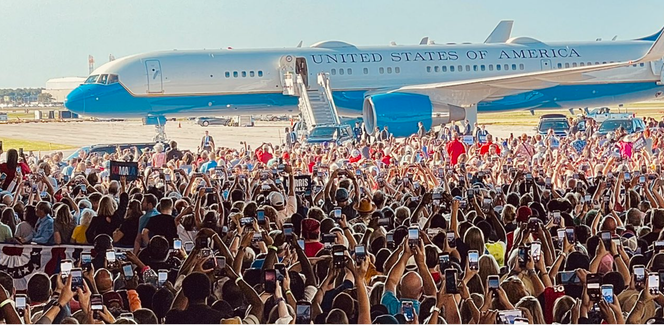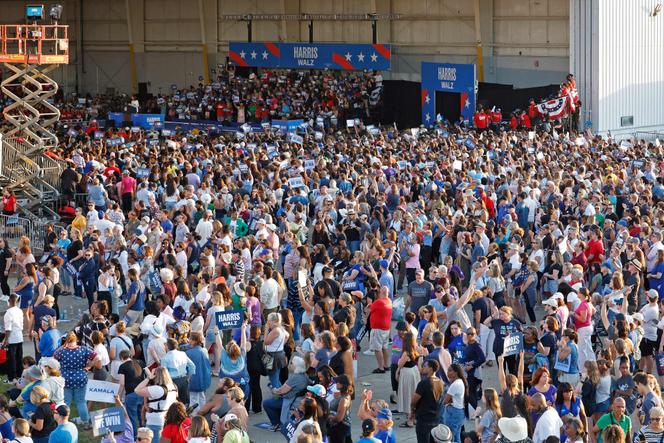


On August 10, on his Truth Social network, Donald Trump accused his rival Kamala Harris of faking photos of her arrival at Detroit airport, where she was holding a meeting with her running mate Tim Walz. "There was nobody at the plane, and she 'A.I.'d' it, and showed a massive 'crowd' of so-called followers, BUT THEY DIDN'T EXIST!" alleged the former US president. "This is the way the Democrats win Elections, by CHEATING – And they're even worse at the Ballot Box" added the Republican candidate, who continues to insist that his rival Joe Biden's election victory in November 2020 was "stolen." In his message, he called for the vice president to be "disqualified" for this "fake image" that constitutes "election interference."
Trump cited an analysis from a Trump activist claiming that the crowd not being reflected in the plane's fuselage was proof that the audience had been added digitally. However, video footage of the scene taken by Harris's campaign manager, as well as many reports from local and national US media easily resolved this seeming contradiction by showing that the substantial number of Democratic activists were actually in a hangar located away from the tarmac. Photographed from behind with a long focal length, they appeared much closer to the aircraft than they actually were, as illustrated by a 3D reconstruction. As the aircraft's fuselage is cylindrical, it only reflects a crushed, barely perceptible reflection. An optical effect that Donald Trump misinterpreted as a magic trick performed by artificial intelligence.
But while the photo showed signs of HDR (high dynamic range, an automated digital processing that corrects backlighting), it features "no evidence of AI-generation," said Hany Farid, professor of computer science at UC Berkeley and a specialist in visual retouching. "This is an actual photo of a 15,000-person crowd for Harris-Walz in Michigan," retorted, a touch mockingly, Harris's official campaign account, without managing to convince the opposite camp.

Supporters of the Republican billionaire declined the accusation and increased the number of suspicious posts on social media, with zoomed-in images and red circles, claiming that this or that face, this or that deformed arm in a meeting photo would be the sign of an artificially generated audience.
"Kamala Harris is so unpopular that they have to use AI to fake crowd sizes on TV for her rallies" insisted a pro-Trump poster. "Do these faces and hands look real to you? It’s fake. It’s. All FAKE" added another. Back in late July, a CNN reporter already had to defend herself for having altered a photo, taken with her iPhone, of a line of Democrats at a fundraiser.
Most of these accusations are based on extremely zoomed-in details, often showing blurred or even deformed faces. Here again, the explanation is technical: from a certain extreme degree of magnification, the number of pixels in the camera is no longer sufficient to reproduce details as fine as a face.
This kind of limitation is familiar to iPhone users: lacking a true optical zoom, most modern smartphones rely on algorithms to extrapolate the details of very distant objects. While they may look good at a distance, up close they present plenty of distortions.
The frequent conspiratorial attacks by Donald Trump and his supporters show that the billionaire is finding it hard to believe that Harris is gaining momentum in the campaign and is now leading the polls in key swing states, which are often crucial in determining the election outcome.
Faced with these headwinds, the Republican candidate has continued to boast about his popularity. "Nobody's spoken to crowds bigger than me," he claimed at a press conference on Thursday, August 8.
Trump even claimed to have attracted more people in front of the White House on January 6, 2021, than Martin Luther King did for his famous "I have a dream" speech in 1963. In reality, the crowd was about five times smaller, corrected The Telegraph.
Democratic activists have shared fake photos in the past. In March, a fake photo featuring a Trump rally with a crowd size that was roughly multiplied by four was circulated. This kind of example remains marginal, however, and is not based on AI, but on ordinary image duplication techniques.
On the other hand, authentic manipulations on the pro-Trump side use artificial intelligence generation. For example, there is a recent deep fake (an algorithmically generated fake) attributed to Russia by the anti-disinformation medium Newsguard, in which a voice replicating Barack Obama's claims that the attempted assassination of Donald Trump had been sponsored by the Democratic Party.
More recently, Elijah Schaffer, a journalist for the far-right media outlet The Gateway Pundit, also enjoyed sharing an image of a Trumpist crowd, which, in turn, has all the hallmarks of an AI-generated photo.
Translation of an original article published in French on lemonde.fr; the publisher may only be liable for the French version.
